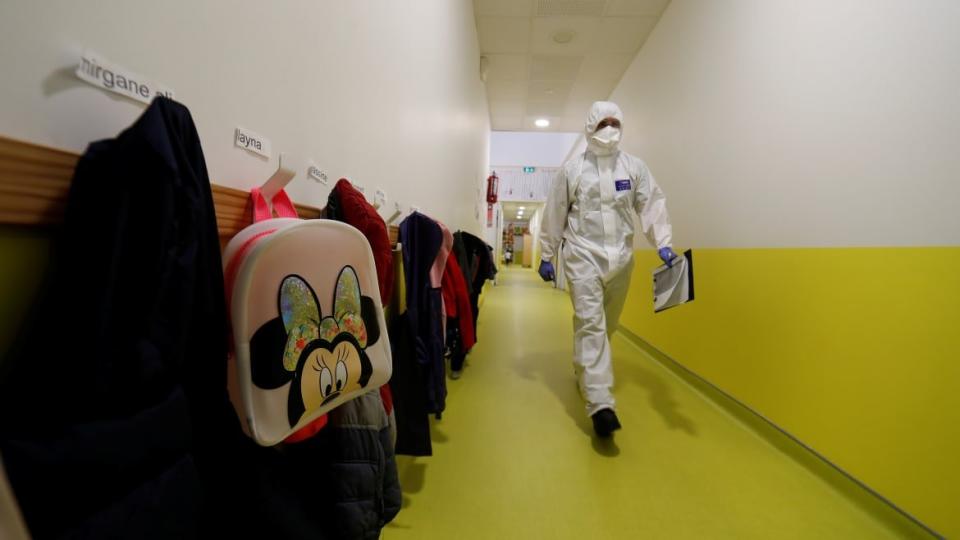Europe Is Locking Down Everything to Keep Schools Open During COVID’s Second Wave

ROME—The Ambrosoni family in the central part of the city here have one computer, painfully slow internet, and three children in elementary school, making learning from home something of a challenge. When schools closed down last March, the children essentially stopped learning, the family says. And the family does not want to see that happen again.
“During the first lockdown in the spring, each child had to sacrifice a third of their school day so their siblings could also attend classes,” mom Gabriella, who is still on furlough from the last lockdown, told The Daily Beast. “Which means they all basically lost the last part of the school year.” And with dad Angelo working at a restaurant—now subject to further restrictions and likely new closures—buying two more computers just isn’t in the cards at the moment.
The Ambrosoni family struggle is mirrored across Europe, where keeping schools open during new lockdowns in the second wave of the pandemic has been a priority. Not only do smaller housing and spotty infrastructure make at-home learning difficult, but in many southern European countries like Italy, where daycare centers are scarce and grandparents as caregivers are now off-limits due to COVID concerns, schools play a vital role in keeping parents at work.
But as European education ministers fight to keep schools open, experts across the continent are warning that while young people do not generally suffer the same consequences of COVID-19, the schools are likely contributing to the rapid spread of the virus. Writing in Bloomberg News, Italian economics analyst Ferdinando Giugliano says the biggest dilemma for governments during the second wave is what to do about schools. “Closing them could lead to a ‘lost generation’ of learners and make it harder for parents to get back to work,” he says. “Keeping them open could further propagate the virus.”
So far, the majority of European governments are struggling to find that balance, and with no centralized European policy, the solutions are quite literally all over the map.
French President Emmanuel Macron announced a nationwide lockdown Wednesday night after his country topped more than 50,000 new cases in a single 24-hour period over the weekend, but schools for the most part will remain open. “I have decided that we must return to confinement,” he said Wednesday night. “The whole territory is concerned.”
The same scenario is playing out in Germany, which is also under new lockdown measures for all leisure activities. There, too, keeping schools open is a priority both to ensure that kids whose families can’t afford multiple computers or who have spotty internet won’t have to sacrifice their children’s education. Addressing the nation to announce new measures on Wednesday, Chancellor Angela Merkel made it clear that “social sacrifices must be made” to ensure schools stay open. “We will do everything so that our children are not the losers of the pandemic,” she said. “School and daycare need to be the most important things.”
In Italy, which is also now under new restrictions until Nov. 24 that include the shuttering of gyms and theaters and the early closure of bars and restaurants at 6 p.m., daycare centers and elementary schools are also being prioritized, while high schools now have to teach 75 percent of their curriculum online and stagger entrances to institutions to ensure proper social distancing. Many Italian high school students are, however, streaming their classes on smartphones rather than computers, calling into question the quality of education they are getting. And the policy isn’t nationwide. The southern region of Puglia ordered all schools closed Thursday after several clusters tied to elementary schools emerged. And the region of Campania, where Naples has become a major hot spot this time after having few cases in the first wave, has waffled in its closures, first shutting down all schools in a lockdown and then opening nursery schools and elementary schools as parents struggled to find adequate daycare without them open.
Other European countries have admittedly lost the battle to keep in-person learning going. The Czech Republic, which has one of Europe’s highest contagion rates after largely avoiding problems in the first wave, closed schools last week. “I apologize to school directors. I apologize to parents for the permanent uncertainty,” Czech Education Minister Robert Plaga said when making the announcement. “But it’s necessary to do it and to do it fast.”
Several studies have pointed to mixed results in whether in-person learning leads to the spread of the virus. A study in Germany by the Institute of Labour Economics in Bonn found no correlation between the opening of its schools in September and the uptick in cases in late October. A similar study in Italy instead found a direct correlation, with more than 2,800 incidents of outbreaks within a month of school starting in mid-September.
A database of global superspreader events being kept by the London School of Hygiene and Tropical Medicine has identified very few incidents within school settings. “Schools should be important given that so many networks come together [there]—with kids, parents, and social life,” Gwen Knight, the project director, told the Financial Times. “But the signal doesn’t seem to be very strong. We are finding it quite hard to find direct evidence of transmission within the school setting, but we are not doing enough testing.”
As the second wave envelopes Europe, most government leaders are trying to keep schools open as long as they can, even as most concede that given how fast the virus is spreading, winter holidays will almost undoubtedly start for students much sooner than usual.
Get our top stories in your inbox every day. Sign up now!
Daily Beast Membership: Beast Inside goes deeper on the stories that matter to you. Learn more.

 Yahoo Finance
Yahoo Finance 